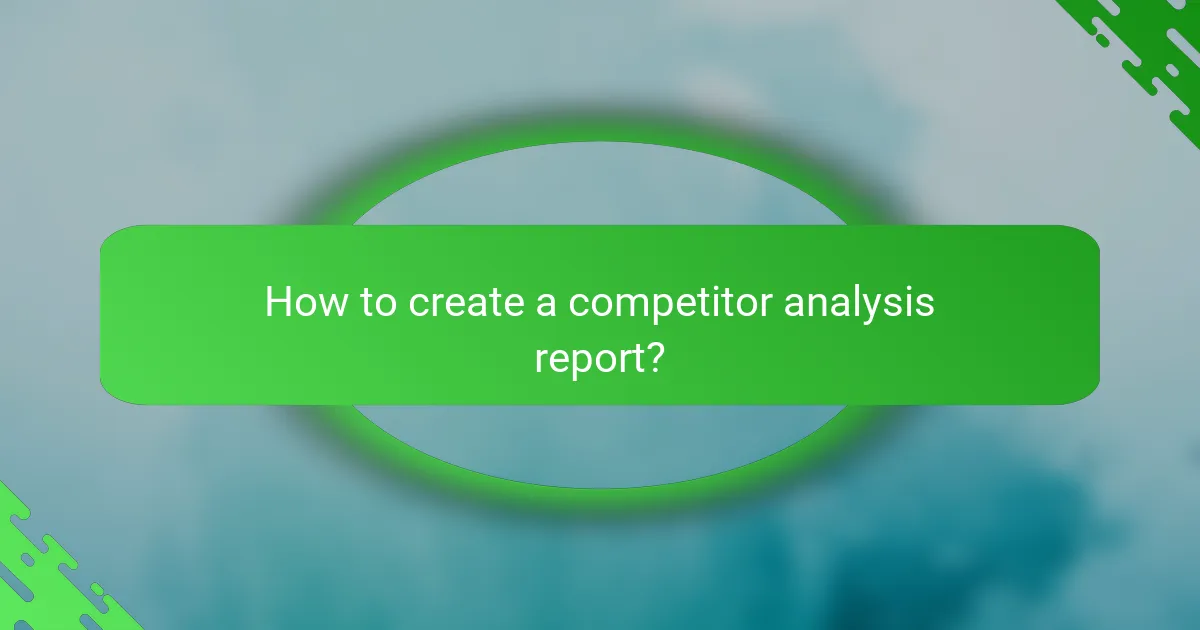Analyzing competitor identities is crucial for businesses aiming to thrive in competitive markets. By benchmarking key metrics and differentiation strategies, companies can uncover valuable insights that inform their strategic decisions and enhance their unique positioning. This process not only highlights strengths and weaknesses but also reveals market dynamics and consumer preferences, enabling businesses to refine their approaches effectively.

How to benchmark competitor identities in e-commerce?
Benchmarking competitor identities in e-commerce involves evaluating key metrics and strategies to understand how your business compares and where it can improve. This process helps identify strengths and weaknesses, guiding your differentiation efforts and strategic decisions.
Identify key performance indicators
Key performance indicators (KPIs) are essential metrics that help measure the success of your competitors. Common KPIs in e-commerce include conversion rates, average order value, customer acquisition cost, and return on investment. Focus on a mix of quantitative and qualitative indicators to get a comprehensive view.
When selecting KPIs, consider industry standards and your specific business goals. For instance, if your competitors have a conversion rate of around 2-5%, aim to understand the factors contributing to their success and how you can achieve similar or better results.
Utilize tools like SEMrush
SEMrush is a powerful tool for analyzing competitor identities, providing insights into their online visibility, traffic sources, and keyword strategies. By entering competitor domains, you can access data on their organic search rankings, paid advertising efforts, and backlink profiles.
Using SEMrush, you can identify which keywords drive traffic to your competitors and their estimated monthly visits. This information can help you refine your own SEO and marketing strategies to better compete in the market.
Analyze market positioning
Market positioning involves understanding how competitors present themselves to customers and where they fit within the market landscape. Assess their branding, messaging, and value propositions to identify what sets them apart.
Consider conducting a comparative analysis of their product offerings, pricing strategies, and customer service approaches. This will help you pinpoint gaps in the market that your business can exploit for differentiation.
Conduct SWOT analysis
A SWOT analysis (Strengths, Weaknesses, Opportunities, Threats) is a valuable framework for evaluating competitor identities. Identify their strengths, such as strong brand loyalty or innovative products, and weaknesses, like poor customer service or limited product ranges.
Additionally, explore opportunities in the market that your competitors may not be capitalizing on, such as emerging trends or underserved customer segments. Recognizing potential threats, such as new entrants or changing consumer preferences, will also help you strategize effectively.

What differentiation strategies can be applied?
Differentiation strategies are essential for businesses to stand out in competitive markets. By identifying and emphasizing unique attributes, companies can create a distinct identity that resonates with their target audience.
Highlight unique selling propositions
Unique selling propositions (USPs) are the specific features or benefits that set a product or service apart from competitors. To effectively highlight USPs, businesses should focus on what makes their offerings unique, such as superior quality, innovative technology, or exceptional customer service.
For example, a tech company might emphasize its cutting-edge software that enhances user experience, while a local bakery could showcase its use of organic ingredients. Clearly communicating these USPs can attract customers who value those specific attributes.
Leverage customer feedback
Customer feedback is a valuable resource for understanding how a business is perceived in the market. By actively soliciting and analyzing feedback, companies can identify areas for improvement and differentiate themselves based on customer needs and preferences.
Utilizing surveys, reviews, and social media interactions can provide insights into what customers appreciate most. For instance, if feedback indicates that customers value fast shipping, a business can prioritize this aspect to enhance its differentiation strategy.
Implement targeted marketing campaigns
Targeted marketing campaigns allow businesses to reach specific segments of their audience with tailored messages. By understanding the demographics, interests, and pain points of their target market, companies can create campaigns that resonate more effectively.
For example, a fitness brand might develop campaigns focused on health-conscious millennials through social media platforms they frequent. This approach not only enhances engagement but also reinforces the brand’s unique identity in a crowded marketplace.

What insights can be gained from competitor analysis?
Competitor analysis provides valuable insights into market dynamics, consumer preferences, and strategic positioning. By examining competitors, businesses can uncover trends, identify opportunities, and refine their own strategies to enhance competitiveness.
Understand consumer behavior trends
Analyzing competitors helps businesses grasp consumer behavior trends by revealing how similar brands engage their audiences. Observing competitors’ marketing strategies, customer feedback, and product offerings can highlight what resonates with consumers and what doesn’t.
For instance, if a competitor sees increased sales after launching a sustainable product line, it may indicate a growing consumer preference for eco-friendly options. Tracking these trends allows businesses to adapt their offerings accordingly.
Identify gaps in the market
Competitor analysis can pinpoint gaps in the market that your business can exploit. By assessing competitors’ strengths and weaknesses, you can discover unmet needs or underserved segments within your target audience.
For example, if competitors focus heavily on premium products but neglect budget-conscious consumers, there may be an opportunity to introduce a more affordable option. Identifying these gaps can lead to innovative product development and targeted marketing strategies.
Evaluate pricing strategies
Understanding competitors’ pricing strategies is crucial for positioning your own products effectively. Analyzing how competitors price their offerings can provide insights into market expectations and consumer willingness to pay.
For instance, if most competitors price similar products within a certain range, it may be wise to align your pricing accordingly to avoid alienating potential customers. However, if you can offer unique features or superior quality, consider a premium pricing strategy to reflect that value.

What tools are effective for competitor analysis?
Effective competitor analysis tools help businesses understand their rivals’ strategies, strengths, and weaknesses. Utilizing the right tools can provide insights into backlinks, traffic sources, and overall market positioning.
Use Ahrefs for backlink analysis
Ahrefs is a powerful tool for analyzing competitors’ backlink profiles. It allows you to see which websites link to your competitors, the quality of those links, and the keywords they rank for. This information can help you identify potential link-building opportunities and understand your competitors’ SEO strategies.
When using Ahrefs, focus on metrics like Domain Rating (DR) and the number of referring domains. A higher DR indicates a more authoritative site, while a diverse range of referring domains can signal a robust backlink strategy. Aim to analyze at least the top five competitors to get a comprehensive view.
Employ SimilarWeb for traffic insights
SimilarWeb provides valuable insights into competitors’ web traffic, including visitor numbers, sources, and engagement metrics. This tool can help you gauge the effectiveness of your competitors’ marketing strategies and identify trends in your industry.
To maximize SimilarWeb’s utility, look at traffic sources such as direct visits, referrals, and social media. Understanding where your competitors’ traffic comes from can inform your own marketing efforts. Regularly check these metrics to spot shifts in competitor performance and adjust your strategy accordingly.

How to create a competitor analysis report?
Creating a competitor analysis report involves gathering relevant data about your competitors and synthesizing it into actionable insights. This process helps identify strengths, weaknesses, and market opportunities that can inform your strategic decisions.
Compile data into actionable insights
Start by collecting data on key aspects such as pricing, product features, customer reviews, and marketing strategies of your competitors. Use online tools and resources to gather this information, ensuring you cover a broad spectrum of competitors in your market.
Once you have the data, analyze it to identify patterns and trends. For instance, if several competitors offer similar features at a lower price, this could indicate a market trend you need to address. Focus on converting raw data into insights that can guide your business strategy.
Visualize findings with charts
Visualizing your findings through charts and graphs can make complex data more digestible and highlight key insights effectively. Use bar charts to compare pricing strategies or line graphs to show market share changes over time.
Tools like Excel or Google Sheets can help create these visualizations. Aim for clarity and simplicity; avoid cluttered visuals that may confuse the audience. Effective charts can enhance presentations and reports, making your analysis more persuasive and actionable.

What are the best practices for ongoing competitor monitoring?
Ongoing competitor monitoring involves systematically tracking competitor activities to gain insights and maintain a competitive edge. Best practices include setting up alerts for competitor activities and regularly updating analysis reports to reflect market changes.
Set up alerts for competitor activities
Establishing alerts for competitor activities allows you to stay informed about their latest moves. Utilize tools like Google Alerts, social media monitoring platforms, or specialized software to receive notifications about new product launches, marketing campaigns, or changes in pricing.
Consider setting alerts for specific keywords related to your competitors, including their brand names, product lines, and industry terms. This proactive approach ensures you can quickly respond to any significant developments that may impact your business strategy.
Regularly update analysis reports
Regularly updating your analysis reports is crucial for maintaining accurate insights into your competitors’ strategies. Schedule these updates monthly or quarterly, depending on the pace of changes in your industry, to ensure your information remains relevant.
Include key metrics such as market share, pricing strategies, and customer feedback in your reports. A well-structured report can highlight trends and shifts in the competitive landscape, enabling you to make informed decisions and adjust your strategies accordingly.



